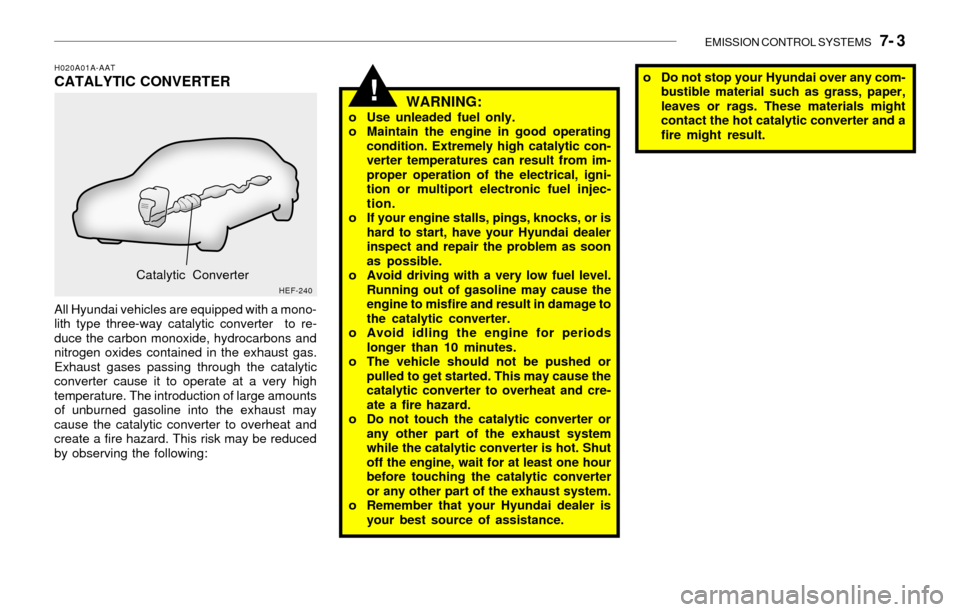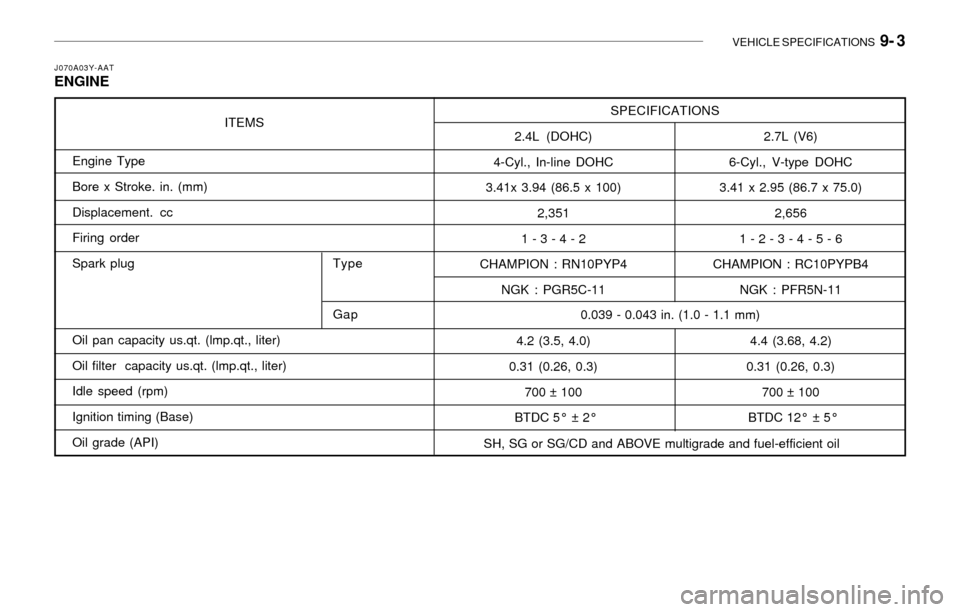2003 Hyundai Sonata fuel
[x] Cancel search: fuelPage 187 of 205

7- 2 EMISSION CONTROL SYSTEMS
H010E01Y-AATEGR System (If installed)
This system helps reduce nitrogen oxides by
recirculating a part of the exhaust gas into the
engine, thereby reducing cylinder combustion
temperature, which results in lower output of
oxides of nitrogen.
H010D01A-AAT3. Exhaust Emission Control System
The Exhaust Emission Control System is a
highly effective system which controls exhaust
emissions while maintaining good vehicle
performace.
H010B01A-AAT1. Crankcase Emission Control
System
The positive crankcase ventilation system is
employed to prevent air pollution caused by
blow-by gases being emitted from the crank-
case. This system supplies filtered air to the
crankcase through the air intake hose. Inside
the crankcase, the fresh air mixes with blow-by
gases, which then pass through the PCV valve
and into the induction system.
H010A01L-AATEMISSION CONTROL SYSTEM
Your Hyundai is equipped with an emission
control system to meet all requirements of the
U.S. Environmental Protection Agency or Cali-
fornia Air Resources Board.
There are three emission control systems which
are as follows.
(1) Crankcase emission control system
(2) Evaporative emission control system
(3) Exhaust emission control system
In order to assure the proper function of the
emission control systems, it is recommended
that you have your car inspected and main-
tained by an authorized Hyundai dealer in ac-
cordance with the maintenance schedule in this
manual.
Caution for Inspection and Maintenance
Test (2.7 V6 Vehicle with Traction Control
System)
o To prevent the vehicle from misfiring
during dynamometer testing, discon-
nect the ABS connector located on the
left side of the engine compartment.
o For more information, see shop manual
(BR-67, Wheel Speed Sensor)
H010C02S-AAT
2. Evaporative Emission Control
(Including ORVR: Onboard Refueling
Vapor Recovery) System
The Evaporative Emission Control System is
designed to prevent fuel vapors from escaping
into the atmosphere.
(The ORVR system is designed to allow the
vapors from the fuel tank to be loaded into a
canister while refueling at the gas station, pre-
venting the escape of fuel vapors into the
atmosphere.)
Canister
Fuel vapors generated inside the fuel tank are
absorbed and stored in the onboard canister.
When the engine is running, the fuel vapors
absorbed in the canister are drawn into the
surge tank through the purge control solenoid
valve.
Purge Control Solenoid Valve (PCSV)
The purge control solenoid valve is controlled
by the Engine Control Module (ECM); when the
engine coolant temperature is low during idling,
the PCSV closes so that evaporated fuel is not
taken into the engine. After the engine warms-
up during ordinary driving, the PCSV opens to
introduce evaporated fuel to the engine.
Page 188 of 205

EMISSION CONTROL SYSTEMS 7- 3
!WARNING:o Use unleaded fuel only.
o Maintain the engine in good operating
condition. Extremely high catalytic con-
verter temperatures can result from im-
proper operation of the electrical, igni-
tion or multiport electronic fuel injec-
tion.
o If your engine stalls, pings, knocks, or is
hard to start, have your Hyundai dealer
inspect and repair the problem as soon
as possible.
o Avoid driving with a very low fuel level.
Running out of gasoline may cause the
engine to misfire and result in damage to
the catalytic converter.
o Avoid idling the engine for periods
longer than 10 minutes.
o The vehicle should not be pushed or
pulled to get started. This may cause the
catalytic converter to overheat and cre-
ate a fire hazard.
o Do not touch the catalytic converter or
any other part of the exhaust system
while the catalytic converter is hot. Shut
off the engine, wait for at least one hour
before touching the catalytic converter
or any other part of the exhaust system.
o Remember that your Hyundai dealer is
your best source of assistance.
H020A01A-AATCATALYTIC CONVERTER
All Hyundai vehicles are equipped with a mono-
lith type three-way catalytic converter to re-
duce the carbon monoxide, hydrocarbons and
nitrogen oxides contained in the exhaust gas.
Exhaust gases passing through the catalytic
converter cause it to operate at a very high
temperature. The introduction of large amounts
of unburned gasoline into the exhaust may
cause the catalytic converter to overheat and
create a fire hazard. This risk may be reduced
by observing the following:o Do not stop your Hyundai over any com-
bustible material such as grass, paper,
leaves or rags. These materials might
contact the hot catalytic converter and a
fire might result.
Catalytic Converter
HEF-240
Page 197 of 205

9- 2 VEHICLE SPECIFICATIONS
J060A01Y-AAT
FUEL SYSTEM
J050A02Y-AATBRAKE
J040A03Y-AATELECTRICAL
J030A04Y-AATTIRE
J020A01Y-AAT
POWER STEERING
J010A03Y-AATMEASUREMENT
186.9 in. (4747 mm)
71.7 in. (1820 mm)
55.9 in. (1422 mm)
106.3 in. (2700 mm)
60.6 in. (1540 mm)
60.2 in. (1530 mm) Overall length
Overall width
Overall height (unladen)
Wheel base
Wheel tread
Front
Rear
Type
Wheel free play
Rack stroke
Oil pump typeRack and pinion
0 ~ 1.18 in. (0 ~ 30 mm)
5.75 in. (146 mm)
5.6 in. (142 mm)
Vane type
Tire pressure
30 (207)
60 (414)Tire
Standard
Spare
Item
Battery
Generator2.4L
MF 60AH (12V)2.7L (V6)
MF 68 AH (12V)
95A (13.5 V)
Dual hydraulic with brake booster
solid disc
Disc type (with ABS)
Drum type (without ABS)
Cable operated on rear wheel Type
Front brake type
Rear brake type
Parking brake
17.2 us.gal (14.3 lmp.gal, 65 liter)
psi (kpa)
Size
P 205/65R15
P205/60R16
T125/80R15Fuel tank capacity 15" tire
16" tire
Page 198 of 205

VEHICLE SPECIFICATIONS 9- 3
J070A03Y-AATENGINE
ITEMS
Engine Type
Bore x Stroke. in. (mm)
Displacement. cc
Firing order
Spark plugType
Gap
Oil pan capacity us.qt. (lmp.qt., liter)
Oil filter capacity us.qt. (lmp.qt., liter)
Idle speed (rpm)
Ignition timing (Base)
Oil grade (API)2.4L (DOHC)
4-Cyl., In-line DOHC
3.41x 3.94 (86.5 x 100)
2,351
1 - 3 - 4 - 2
CHAMPION : RN10PYP4
NGK : PGR5C-11
4.2 (3.5, 4.0)
0.31 (0.26, 0.3)
700 ± 100
BTDC 5° ± 2°2.7L (V6)
6-Cyl., V-type DOHC
3.41 x 2.95 (86.7 x 75.0)
2,656
1 - 2 - 3 - 4 - 5 - 6
CHAMPION : RC10PYPB4
NGK : PFR5N-11
4.4 (3.68, 4.2)
0.31 (0.26, 0.3)
700 ± 100
BTDC 12° ± 5°
SPECIFICATIONS
0.039 - 0.043 in. (1.0 - 1.1 mm)
SH, SG or SG/CD and ABOVE multigrade and fuel-efficient oil
Page 202 of 205

INDEX 10- 3
E
Emission Control System ................................................................... 7-2
Engine
Before starting the engine .............................................................. 2-3
Compartment (2.4 DOHC) ............................................................ 6-2
Compartment (2.7 V6) ................................................................... 6-3
Coolant ........................................................................................... 6-7
Coolant temperature gauge .........................................................1-38
If the engine overheats .................................................................. 3-3
Number........................................................................................... 8-2
Oil .................................................................................................... 6-5
Starting ........................................................................................... 2-4
Engine Exhaust Can Be Dangerous .................................................. 2-2
F
Fan Speed Control ............................................................................1-66
Floor Mat Anchor ..............................................................................1-62
Fog Light
Front.............................................................................................1-42
Front Seats
Adjustable front seats ..................................................................1-10
Adjustable headrests ...................................................................1-11
Adjusting seat forward and rearward ..........................................1-10
Adjusting seatback angle .............................................................1-11
Fuel
Capacity......................................................................................... 9-2
Gauge...........................................................................................1-38
Unleaded gasoline .......................................................................... 1-2
Fuel Filler Lid
Remote release ............................................................................1-58
Fuses................................................................................................6-18G
General Everyday Checks ................................................................. 6-4
Glove Box ..........................................................................................1-50
H
Hazard Warning System ..................................................................1-44
Headlight .................................................................................. 1-41, 6-21
Heating and Cooling Control
Rotary and push Button type .......................................................1-65
Automatic type .............................................................................1-72
Heating and Ventilation
Air flow control ..............................................................................1-67
Temperature control ....................................................................1-66
High-Mounted Rear Stop Light .........................................................1-58
Homelink Mirror .................................................................................1-53
Hood Release ....................................................................................1-59
Horn...................................................................................................1-60
I
Ignition Switch ...................................................................................... 2-3
Instrument Cluster and Indicator Lights ...........................................1-34
Instrument Panel Light Control (Rheostat) .......................................1-45
Interior Light .......................................................................................1-49
Intermittent Wiper ..............................................................................1-43
J
Jump Starting ...................................................................................... 3-2
Junction Box Description ..................................................................6-29
Page 205 of 205

Seoul KoreaPrinting: FEB. 10, 2002
Publication No.: A38O-EU32I
Printed in Korea
SERVICE STATION INFORMATION
FUEL:
UNLEADED gasoline only
Pump Octane Rating of 87 (Research Octane Number 91) or higher.
FUEL TANK CAPACITY
US.gal (Imp.gal., liter) 17.2 (14.3, 65)
TIRE PRESSURE:
See the label on the driver's side of the center pillar outer panel.
OTHER TIRE INFORMATION:
See pages 8-2 through 8-6
HOOD RELEASE:
Pull handle under left side of dash.
ENGINE OIL:
API grade SH, SG or SG/CD multigrade and fuel efficient oil. Use SAE
10W-30, 10W-40 or 10W-50 if normal temperatures are above -10°F
(-23°C). For other viscosity recommendations, see page 6-5 or 9-4.
MANUAL TRANSAXLE:
HYUNDAI GENUINE PARTS MTF 75W/90 (API GL-4) Oil level
should be up to filler-bolt hole in housing beside differential.
AUTOMATIC TRANSAXLE:
Apply the parking brake, with the engine running, shift the selector
lever through all ranges and return to “N” (Neutral) position. Then
check the level of fluid on the dipstick. Use only HYUNDAI GENU-
INE ATF available at your dealer or DIAMOND ATF SP-III or SK
ATF SP-III.
QUICK INDEX
o Car will not start ....................................................................... 3-2
o Flat tire ..................................................................................... 3-5
o Warning light/chime comes on .............................................. 1-35
o Engine overheats ...................................................................... 3-3
o Towing of your vehicle ............................................................. 3-9
o Starting the engine ................................................................... 2-3
o Driving tips for first 1,200 miles (2,000 km) .......................... 1-3
o Scheduled maintenance ............................................................ 5-4
o Reporting safety defects ........................................................... 8-7